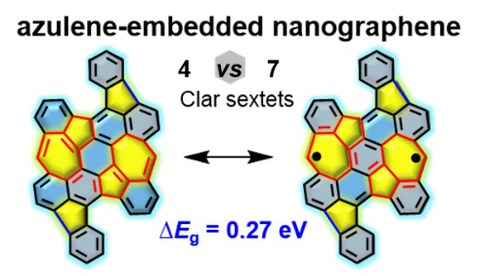Jul 24, 2019
Open-shell Non-benzenoid Nanographenes Containing Two Pairs of Pentagonal and Heptagonal Rings
Extended polycyclic aromatic hydrocarbons, or nanographenes, which can be regarded as finite graphene segments composed of sp2-conjugated carbon atoms, have attracted tremendous interest in the last two decades due to their intriguing electronic and optoelectronic properties, leading to potential applications in organic electronics. However, most reported nanographenes consist solely of benzenoid rings. Non-benzenoid odd-membered polycycles such as pentagons and heptagons occur in graphene as localized defects and extended grain boundaries, and may significantly influence the physicochemical properties of corresponding nanostructures, arising from local changes in strain and conjugation. The known methods of graphene fabrication, however, fail to offer a rational control over the formation of non-benzenoid topologies. This limitation thus motivates their atomically-precise synthesis and comprehensive characterizations.
The group of scientists from the Chair of Molecular Functional Materials of Prof. Xinliang Feng, Prof. Klaus Müllen (MPIP) and Prof. Roman Fasel (EMPA, Zurich, Switzerland) have demonstrated a combined bottom-up in-solution and on-surface synthetic approach, reported the synthesis of non-benzenoid open-shell nanographenes containing two pairs of embedded pentagonal and heptagonal rings. The 5-7 rings embedded nanographene displays an extremely narrow energy gap of 0.27 eV and exhibits a pronounced open-shell biradical character close to 1 (y0=0.92), in which the spin densities are localized on the edges of heptagonal rings. The experimental results are supported by mean-field and multi-configurational quantum chemical calculations. Access to large nanographenes with a combination of non-benzenoid topologies and open-shell character should have wide implications in harnessing new functionalities toward the realization of future organic electronic and spintronic devices.
This work was financially supported by European Union’s Horizon 2020 research and innovation program under grant agreement No 696656 (Graphene Flagship Core2), the German Research Foundation (DFG) within the Cluster of Excellence “Center for Advancing Electronics Dresden (cfaed)” and EnhanceNano (No. 391979941), the European Social Fund and the Federal State of Saxony (ESF-Project “GRAPHD”, TU Dresden), the Swiss National Science Foundation and the NCCR MARVEL funded by the Swiss National Science Foundation.

